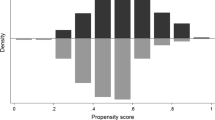Abstract
The policies determining how the foreign born enter the United States are some of the most complicated, least understood, and most disliked of all federal policies. This paper uses New Immigrant Survey (2003) data to examine how proposed changes to U.S. immigration policy might alter the composition of legal permanent residents (LPRs) admitted. Specifically, we consider the 2007 federal proposal that would have placed greater emphasis on employment and skills by instituting a merit-based point system while eliminating some types of family sponsorship. We also simulate point scores for the 2003 LPR cohort according to the point systems used in Canada and Australia. We find that, despite significant variation in point allocations, the three systems would admit similar numbers and types of immigrants. In the 2007 U.S. proposal, work experience in the United States is extremely important for earning high point scores. Thus, the proposal would place even more stress on temporary visa programs.



Similar content being viewed by others
Notes
For the text of Senate Bill 1639, see http://thomas.loc.gov/cgi-bin/bdquery/ z?d110:S.1639:.
There are two notable differences. One is the decline in the percentage of those born in Mexico (at 21% in 2000, 16% in 2003, and 14% in 2006). This decline is likely due to a decrease in the number of eligible Mexican-born immigrants legalized under the Immigration Reform and Control Act. There is a similar decline in the proportion of all legal immigrants who are family sponsored, numerically limited immigrants (28% in 2000, 23% in 2003, and 18% in 2006). The second notable difference is the lower percentage of adjustees.
These sample characteristics may vary somewhat from those that are reported by USCIS. The NIS sample is also only LPRs ages 18 and older. Also, see footnote 2.
Specialty, high-demand, and STEM/health are occupational designations that are important to the 2007 U.S. proposal. Please see the discussion in section 4.1 for more detailed definitions.
We include principals and any nonprincipal spouses. Robustness checks where we included only the principals resulted in point distributions that were nearly identical—at only a few point scores do the percentiles differ by more than 1%.
Points for apprenticeships certified by the Department of Labor cannot be allocated because of data limitations (see Table 3). As a robustness check, we allocated these points to those individuals who might be eligible (eight points were granted to those with no educational attainment, three more for those who already had five points from a vocational certification). We found that the curve shifted only slightly, and those results are not shown here.
References
Antecol, H., Cobb-Clark, D. A., & Trejo, S. J. (2003). Immigration policy and the skills of immigrants to Australia, Canada, and the United States. The Journal of Human Resources, 38(1), 192–218.
Borjas, G. (1991). Immigration and self-selection. In J. M. Abowd & R. B. Freeman (Eds.), Immigration, trade, and the labor market. Chicago: University of Chicago Press.
Brookings-Duke Immigration Policy Roundtable (2009) Breaking the immigration stalemate: From deep disagreements to constructive proposals. Durham, North Carolina: The Kenan Institute for Ethics at Duke University.
Citizenship and Immigration Canada (2008) Facts and figures: Immigration overview permanent and temporary residents. Ottawa, ON, Canada: Communications Branch, Citizenship and Immigration Canada.
Cobb-Clark, D. A. (2000). Do selection criteria make a difference? Visa category and the labour market status of immigrants to Australia. The Economic Record, 76(232), 15–30.
Department of Immigration and Citizenship (2009) Immigration update 2008–09. Commonwealth of Australia.
Green, A. G., & Green, D. A. (1995). Canadian immigration policy: The effectiveness of the point system and other instruments. The Canadian Journal of Economics, 28(4b), 1006–1041.
Hecker, D. E. (2005). Occupational employment projections to 2014. Monthly Labor Review, November 2005, Table 3.
Jasso, G. (1988). Whom shall we welcome? Elite judgments of the criteria for the selection of immigrants. American Sociological Review, 53(6), 919–932.
Jasso, G., Massey, D. S., Rosenzweig, M. R., & Smith, J. P. (2006). The new immigrant survey 2003 round 1 (NIS-2003-1) public release data. http://nis.princeton.edu.
Jasso, G., & Rosenzweig, M. R. (1995). Do immigrants screened for skills do better than family-reunification immigrants? International Migration Review, 29, 85–111.
Jasso, G., & Rosenzweig, M. R. (2008). Selection criteria and the skill composition of immigrants: A comparative analysis of Australian and U.S. employment immigration. IZA Discussion Paper No. 3564.
Monger, R., & Rytina, N. (2009). U.S. legal permanent residents: 2008. Annual Flow Report, Office of Immigration Statistics, Policy Directorate. Washington, DC: Department of Homeland Security.
Office of Immigration Statistics. (2004). Characteristics of specialty occupation workers (H-1B): Fiscal year 2003. Washington, DC: Department of Homeland Security.
Office of Immigration Statistics. (2007). 2006 Yearbook of immigration statistics. Washington, DC: Department of Homeland Security.
Terrell, N. (2007). STEM occupations. Occupational Outlook Quarterly, 51(1), 26–33.
Wanner, R. A. (2003). Entry class and the earnings attainment of earnings to Canada, 1980–1995. Canadian Public Policy, 29(1), 53.
Acknowledgments
The authors gratefully acknowledge the advice and comments of Guillermina Jasso, Mark Silverman, Steven Camarota, Sabina Ohri, Hans Johnson, Deborah Reed, Gary Bjork, Michele Waslin, Pat Bedrosian, Edward Kissam, Magnus Lofstrom, and two anonymous reviewers.
Author information
Authors and Affiliations
Corresponding author
Rights and permissions
About this article
Cite this article
Hill, L.E., Hayes, J.M. How would selecting for skill change flows of immigrants to the United States? A simulation of three merit-based point systems. Rev Econ Household 9, 1–23 (2011). https://doi.org/10.1007/s11150-010-9097-y
Received:
Accepted:
Published:
Issue Date:
DOI: https://doi.org/10.1007/s11150-010-9097-y




